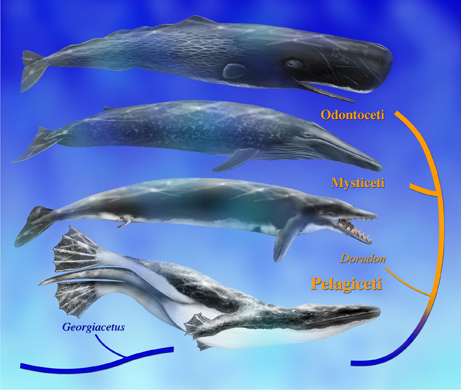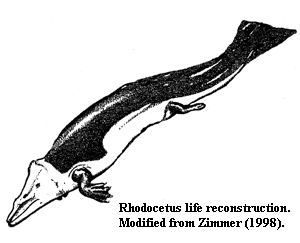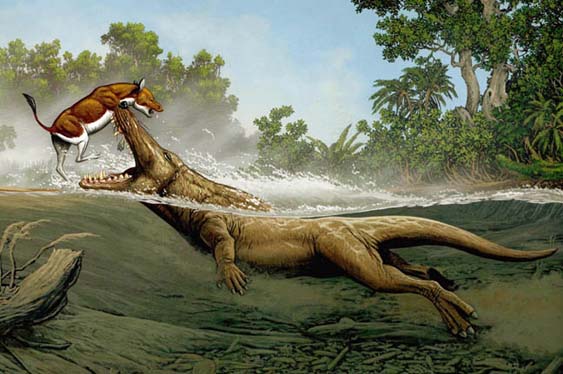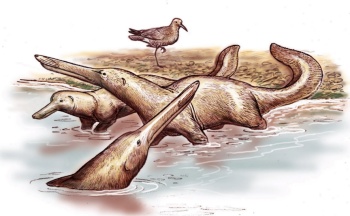Sea Serpent Candidates: Georgiacetus & The Ancient Whales
Posted by: Loren Coleman on September 18th, 2008
A new article on the ancient origins of flukes in whales (specifically, Georgiacetus, here) reminds me that there are some perfectly good candidates among the not-so-ancient whales and their precursors who might live on as undiscovered survivors out there. Their contemporary evolved offspring may have been reported in the last few hundred years and today as “Sea Serpents.”
Take a look at some of these beautiful species.


Ambulocetid cetaceans are slightly younger and more derived than pakicetid cetaceans. They were also much larger, similar in size to large sea lions. A nearly complete skeleton for Ambulocetus (below) shows that the animal had a large head, long muscular body, and a long tail. Its limbs were short but the feet long. In overall body shape, Ambulocetus looked somewhat like a crocodile, although its hind limbs and feet were considerably longer. It may have lived as an ambush predator of fish in shallow water.


Last, but not least, the following is a reconstruction of the extra special-looking remingtonocetid Kutchicetus, which was a small animal, no bigger than a river otter. Illustration by Carl Buell.

About Loren Coleman
Loren Coleman is one of the world’s leading cryptozoologists, some say “the” leading living cryptozoologist. Certainly, he is acknowledged as the current living American researcher and writer who has most popularized cryptozoology in the late 20th and early 21st centuries.
Starting his fieldwork and investigations in 1960, after traveling and trekking extensively in pursuit of cryptozoological mysteries, Coleman began writing to share his experiences in 1969. An honorary member of Ivan T. Sanderson’s Society for the Investigation of the Unexplained in the 1970s, Coleman has been bestowed with similar honorary memberships of the North Idaho College Cryptozoology Club in 1983, and in subsequent years, that of the British Columbia Scientific Cryptozoology Club, CryptoSafari International, and other international organizations. He was also a Life Member and Benefactor of the International Society of Cryptozoology (now-defunct).
Loren Coleman’s daily blog, as a member of the Cryptomundo Team, served as an ongoing avenue of communication for the ever-growing body of cryptozoo news from 2005 through 2013. He returned as an infrequent contributor beginning Halloween week of 2015.
Coleman is the founder in 2003, and current director of the International Cryptozoology Museum in Portland, Maine.










Beautiful species indeed.
“Their contemporary evolved offspring may have been reported in the last few hundred years and today as “Sea Serpents.””
I’d say that’s a pretty good possible explanation for recent sea serpent sightings. The Georgiacetus is a pretty wild looking critter, and who knows what other evolutionary variations may be swimming around out there. Considering all the relatively new giant squid evidence that deep sea exploration with subs has uncovered recently, it’s not too much of a leap to consider the possibility of an undiscovered whale species that may look a bit different than what we are accustom to. If only one would just wash up onshore intact….
cliff
Does the Kutchicetus remind anybody of the Dobhar-chu?
“Scientists have known whales evolved from semi-aquatic, four-footed creatures with long, thin tails to today’s fully aquatic mammals with fluked tails, no back legs, and flippers instead of front legs.” One of the things that bothers me about articles like this is the use of “Scientists have known” instead of “Scientists speculate.” They can not show or demonstrate definitively that “whales evolved from semi-aquatic, four-footed creatures with long, thin tails to today’s fully aquatic mammals with fluked tails, no back legs, and flippers instead of front legs.” Why can they not all be individual and separate creatures? This makes more sense. The third picture looks more like a crocodile or alligator to me.
Read At the Water’s Edge by Carl Zimmer. The very best book on whale evolution available to the lay-person and simple-minded individuals such as myself 😉
Since many of the sea serpent and lake monster sightings have been from cooler climates, the warm-blooded nature of whales may have given them an advantage.
Has any body else noticed how much like a primate’s hands the front feet of Ambulocetus look? From the way that picture is drawn one would almost think this was some kind of a hybrid between a kangaroo and an alligator/crocodile with the upper limbs of a primate. Now that would be one heck of a cryptid. 😀
Ambulocetus would make a great bunyip.
Kutchicetus resembles a platypus with an extended bill, legs and a much longer tail.
Well, shoot, in the oceans anything’s possible.
But that’s the rub, if we’re talking about this from a scientific perspective. We need to see evidence, which would include lots of sightings which ARE INTERNALLY CONSISTENT. That is something that seems to me lacking when we talk about sea serpents, lake monsters and the like. Lots of people see stuff in the water. But it starts falling apart when one tries to categorize it and come up with commonalities. As Myra Shackley says: we’re looking for frequency and coherence. And not even Nessie, in my humble, lives up to that standard. (Maybe frequency. But coherence? Phweef.)
I still wonder about that plesiosaur-like thing (photographed) brought up by, I believe, a Japanese trawler a number of years back. One photo, a really vague article, and then nothing else. What was THAT? I wonder how many finds like that just got tossed overboard because the livelihoods of the crew – can’t keep this on board, it’ll spoil the catch – combined with fear of the unknown (or I-don’t-need-to-know-thanks) to override curiosity.
I will say this, though. For cool insight into what evolution can come up with, you can’t beat bats and cetaceans.
Absolutely surviving species of ancient whales could be out there if they were able to adapt to any changes that their habitat might have undergone, or managed to evolve to branch out or meet new demands put upon them by their environment. The oceans continually amaze and surprise us, and there is a lot that has not been properly explored. In my opinion, the oceans are some of the most promising places for truly remarkable large animal discoveries in the future. The possibility of one of these ancient species surviving is certainly there.
Back around 1980 I did research and made an expedition to investigate the “White River Monster” of Newport AR. Based upon old newspaper photos I decided it looked similar to a zeuglodon, but with legs.
DWA: On April 25, 1977, the Japanese trawler Zuiyo Maru, sailing east of Christchurch, New Zealand, caught a strange, unknown creature in the trawl. Photographs and tissue specimens were taken. While initially identified as a prehistoric plesiosaur, analysis later indicated that the body was the carcass of a basking shark.
“Has any body else noticed how much like a primate’s hands the front feet of Ambulocetus look?”
I think that’s just the generic tetrapod hand…
The Japanese carcass was definitively identified as a shark, see several sources for confirmation of that finding.
Roy Mackal opined that the White River Monster was a very lost elephant seal. See his Searching for Hidden Animals for details.
As to cetaceans and sea serpents:
I group sea serpent reports into two categories. The first is elongated animals. A basilosaur would make a good fit for some reports of elongated animals, though surely is it more likely that a huge eel or eel-like fish (much better equipped to hide from scientists as well as from harpooners) is involved when that also fits the evidence.
The other main grouping of sea serpent reports (the SS Umfuli’s, for example) involve witnesses insisting they clearly saw a long neck much smaller than the body. We have no fossils of any cetacean with a long neck, and indeed they were evolving the other way, until only the beluga and some river dolphins have visible necks at all. The pinnipeds, which have maintained visible, flexible necks and did include one extinct long-necked form we know of, seem like better candidates if these reports do, in fact, concern mammals.
BigfootDad, we know because of the unique earbone that clade/dynasty of mammals has evolved to adapt to the water. Its as distinct as a paleontological fingerprint, and found in all the cetaceans streching back to pakicetus. Ambulocetus DOES look like an alligator, but we have an amazing record of the way gradual changes overtime added up in that evolutionary clade.
Maybe these have something to do with the 2004 reports about the 52hz Cryptowhale?